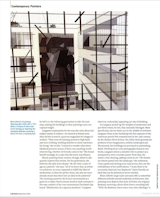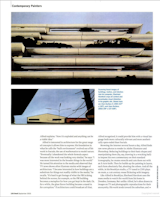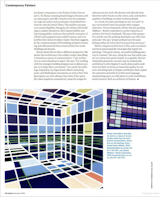As a part of our 25th-anniversary celebration, we’re republishing formative magazine stories from before our website launched. This story previously appeared in Dwell’s September 2003 issue.
Julie Langsam was never meant to practice architecture. Even small sculpture confounds her: Whenever she worked with wood or metal in art school, she’d become so absorbed in one surface that she’d forget all the others. “I don’t have a good idea of three-dimensional space,” she admits. “I think only illusionistically.”
That may explain why her paintings of residential landmarks by Mies, Neutra, and Eisenman look nothing like your average building elevation. For the 43-year-old Langsam, as for a growing number of young painters—from Brian Alfred, 29, to Eberhard Havekost, 36, to Sarah Morris, 36—depicting architecture isn’t about bricks and mortar: It’s a means of rendering in real terms our increasingly amorphous contemporary culture.
Of course, depicting buildings is almost as old as architecture itself. Drawings on ancient scrolls and walls give us a view of archaic dwellings. Gilded medieval church panels telegraphed the glory of God from the great spires of Gothic cathedrals. Modernist painters from Charles Sheeler to Edward Hopper used architectural space to evoke the ambience of their age. In the 1980s and ’90s, the late Los Angeles painter John Register went even further, expressing a full range of emotions (mainly alienation) simply with images of empty motels, apartments, and diners. Register pursued what he called “a refinement of the commonplace,” using snapshots and adapting only the essential to convey a particular mood. Yet, while Register communicated through architecture, he left it to the following generation to take the next step, making the buildings in their paintings carry conceptual weight.
Langsam’s explanation for the way she came about her subject matter is indirect. An interest in female sexuality led her to search 1950s-era magazines for images of women. “They were all running around in high heels and nice clothing, building families in these machines for living,” she recalls. “I started to wonder what these idealized pictures meant, if there was anything worth resurrecting, whether we’d really come so far.” She found herself nostalgic for a past that she knew was illusory.
Merely painting those women, though, failed to adequately express that schism. For her generation, she believes, the split went deeper. “By the time I came of age as a painter,” she says, “all of us knew that, as artists or architects, we were supposed to fulfill the ideal of modernism, to find the perfect form, but also we were already aware that there isn’t an ideal to be achieved.” The stunning austerity she’d once encountered as a guest in a classic Neutra house stood in stark contrast to the easy comfort of her own anonymous Cleveland clapboard. “[Modernism is] a rigorous aesthetic,” Langsam observes, undeniably appealing yet also forbidding.
So Langsam picked up the temples of modernism and put them where, for her, they naturally belonged. More specifically, she set them out in the middle of nowhere. Langsam chose as her backdrops the flat expanses of the American prairie first romanticized in the 19th century by the Hudson River School. Yet, while those grounds are products of her imagination, artfully landscaped and illuminated, the buildings are portrayed in painstaking detail. Working from color photographs found in textbooks, Langsam selects a suitable view to project as a transparency onto a wooden panel. From that, she makes a line drawing, adding colors in oil. “The homes are almost pasted into the landscape,” she elaborates. Unoccupied and lacking even road access, they are the embodiment of her ambivalence. “I want them to be accurately depicted, but displaced.” Quite literally an ideal that can be desired yet never reached.
Brian Alfred’s large-scale canvases offer a somewhat different attitude toward modernist architecture. One painting even depicts that holy of holies, the original Bauhaus, receiving a direct blow from a wrecking ball. “With the Bauhaus, there was a very strict ideology,” Alfred explains. “Now it’s exploded and anything can be a viable idea.”
Alfred is interested in architecture for the great range of concepts it allows him to express. His foundation in what he calls the “built environment” evolved out of his work in fractals, the use of mathematics to model nature. “Eventually I abandoned the whole formula aspect because all the work was looking very similar,” he says. “I was more interested in the broader things in the world.” He turned his attention to the media and observed that TV news shows often illustrate stories with images of architecture. “I became interested in how buildings are a substitute for things not readily visible to the media,” he recalls. “It’s hard to get footage of what the FBI is doing behind the scenes, for example, so the FBI building becomes a metaphor for how you get kept in the dark. Or, for a while, the glass Enron building became a stand-in for corruption.” If architecture could broadcast all that, Alfred recognized, it could provide him with a visual language both more culturally relevant and more aesthetically open-ended than fractals.
Browsing the internet several hours a day, Alfred finds raw news photos to render in Adobe Illustrator and Photoshop. Reducing buildings to their basic shapes and manipulating them (by, say, drawing in a wrecking ball) to impose his own commentary on their standard iconography, he creates stencils and cuts them out with an X-Acto knife. Then he builds up the painting in layers, each form absolutely flat, abutting the others. And all the while, in his Brooklyn studio, a TV tuned to CNN plays on mute, a 21st-century muse flickering with imagery.
Like Alfred in Brooklyn, Eberhard Havekost uses the mass media to watch the world from his home in Dresden, Germany. But unlike Alfred, he’s often drawn to images on TV and photographic reproductions for their anonymity. His work tends toward the suburban, and has drawn comparison to the fiction of John Cheever and A. M. Homes. Scanning found images of houses, trailers, skyscrapers, and office interiors into his computer, he crops all context and accentuates visual distortion—what he calls the formal “flaws.” His smallest canvases even tempt illegibility. Strangely, the refusal of his buildings to explain themselves, their impenetrability and interchangeability, reinforces the symbolic resonance of Alfred’s and Langsam’s more explicit sources, and even justifies their denial of subject matter. Havekost suggests, by the counterexample of his buildings stripped of meaning, how disconnected from actual architecture iconic buildings can become.
Painter Sarah Morris offers a different perspective. She denies that architecture is her subject matter, describing it instead as a means of communication. “I use architecture to create situations in space,” she says. “I’m working with the strategies building designers use to distract people, or to make them concentrate.” As a result, her paintings, inspired by Las Vegas hotels, Miami swimming pools, and Washington monuments, as well as New York skyscrapers, are more abstract than those of her peers. She takes snapshots compulsively, using the images for references in her work. She doesn’t work directly from them but rather focuses on the colors, scale, and emotive qualities of buildings, not their technical details.
As a result, her spare paintings are not “accurate” in any conventional sense but people often imagine otherwise. Viewers frequently tell her that her painting Midtown-Revlon Corporation is a perfect depiction of architect Der Scutt’s landmark. “Because of the perspective and the way the painting dominates you with color and scale,” she says, “people perhaps have the same feeling as [they do when they’re] around that structure.”
Morris compares architecture to film, and even shoots movies in and around the cityscapes that inspire her paintings. “Like good cinema, successful buildings place you in a fantasy,” she says, citing the way that malls compel us to shop and casinos inspire us to gamble. Morris’s minimalist geometric canvases may be aesthetically antithetical to John Register’s nearly photorealist renditions, but their work has an important quality in common, stretching back to Hopper and Sheeler. Both exploit the expressive potential of architectural language, manipulating space on a flat plane to evoke multidimensional emotion. Both are architects of illusion.





